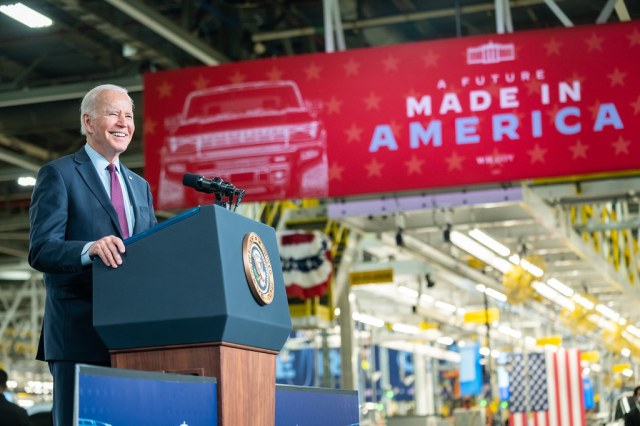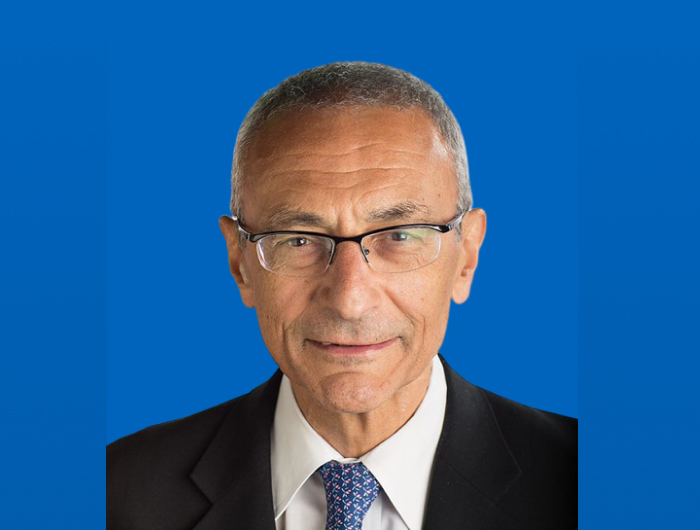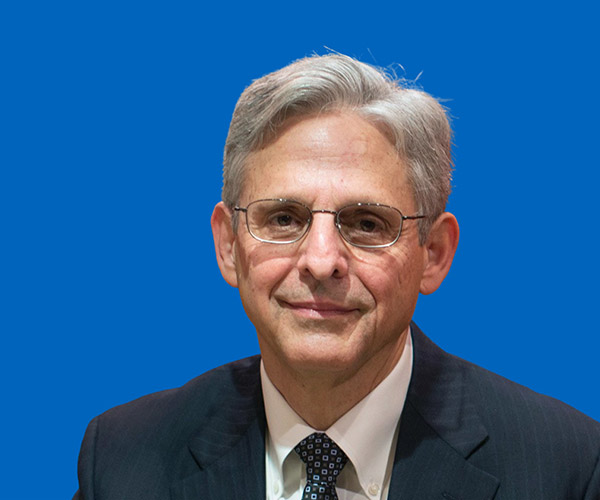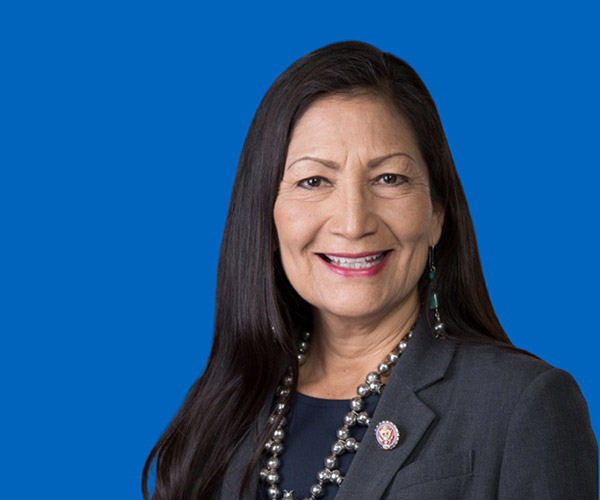President Biden's
Historic Climate Agenda
“This is a case where conscience and convenience cross paths, where dealing with this existential threat to the planet and increasing our economic growth and prosperity are one and the same. When I think of climate change … I think of jobs.”
President Biden’s Actions to Tackle the Climate Crisis
President Biden campaigned on a bold vision of tackling the climate crisis with the urgency that science demands while building a clean energy economy that benefits all Americans—lowering costs for families, creating good-paying jobs for workers, and ensuring healthier air and cleaner water for communities.
As part of that vision, the President set groundbreaking goals:
- Reduce U.S. greenhouse gas emissions 50 to 52 percent below 2005 levels in 2030 and by 61 to 66 percent below 2005 levels in 2035;
- Reach 100 percent carbon pollution-free electricity by 2035;
- Achieve a net-zero emissions economy by 2050; and
- Deliver 40 percent of the overall benefits from certain federal investments in climate and clean energy and other areas to disadvantaged communities.
The Biden-Harris Administration has made massive progress in translating these goals into action and impact on the ground – taking decisive steps to reduce climate pollution; cut energy costs; create good union jobs; increase resilience; advance environmental, economic, and racial justice; improve public health; and achieve energy security. This federal mobilization – building on the leadership of states, Tribal Nations, and local governments – has spurred historic progress that continues to deliver on U.S. climate goals.
Under President Biden’s leadership:
- Congress passed the Inflation Reduction Act – the most significant investment in U.S. history to tackle the climate crisis – and the Bipartisan Infrastructure Law. Together, these bills are saving families hundreds of dollars per year on energy bills; creating good-paying jobs for American workers through clean energy manufacturing; strengthening our resilience to extreme weather events; and delivering cleaner air and water for our children and grandchildren.
- The Administration has taken hundreds of executive actions to reduce climate pollution across every sector of the economy, including on clean electricity, transportation, buildings, and industry, support for climate-smart agriculture and forestry, and targeted actions on super pollutants like methane and hydrofluorocarbons – all while advancing environmental justice and building climate-resilient communities.
- President Biden has conserved more U.S. lands and waters than any President in history, protecting 674 million acres including through new national monuments, marine sanctuaries, and wildlife refuges – all in support of his landmark America the Beautiful initiative to conserve, restore, protect, and connect at least 30 percent of U.S. lands and waters by 2030.
- Companies have announced investments to build more than 900 new or expanded clean energy manufacturing facilities from coast to coast – spurring a manufacturing renaissance creating tens of thousands of good jobs for workers to forge the wind turbines, solar panels, batteries, and electric vehicles needed to support a livable climate and a fairer economy.
- New investments in U.S. clean energy manufacturing, electric vehicles and batteries, and clean power projects have reached over $450 billion during this Administration. Clean energy jobs have grown in every single state, employing more than 3 million Americans across solar, wind, storage, energy efficiency, electric vehicles, and more. Clean energy jobs have grown at more than double the rate of job growth in the rest of the economy.
- For the first time ever, unionization rates in clean energy surpassed the energy sector average, reaching their highest level in history – nearly double union density in the U.S. economy overall.
- During the Administration, the U.S. added more than 100 gigawatts of clean energy to the grid – enough to power more than 25 million homes. The nation’s first new nuclear reactors in over 30 years and first-ever commercial-scale offshore wind projects started operation. More than half of all solar energy ever installed in the U.S. was added during this Administration. Because of Administration actions, U.S. solar generation is projected to increase up to eight-fold, and wind generation is projected to triple by 2030 while lowering electricity costs.
- Electric vehicle (EV) sales have quadrupled, the availability and affordability of clean vehicles has soared, and the U.S. achieved a milestone of 1 million annual EV sales 3 years earlier than forecasters anticipated. The number of public EV chargers has more than doubled to over 200,000 chargers. Companies have announced enough new battery manufacturing capacity in the U.S. to supply as many as 13 million EVs per year by 2030.
- President Biden restored U.S. climate leadership on the world stage by rejoining the Paris climate accords, fulfilling his pledge to increase U.S. international climate finance to over $11 billion a year, launching the President’s Emergency Plan for Adaptation and Resilience (PREPARE) to scale up U.S. support for vulnerable developing countries, galvanizing commitments from other countries to reduce global methane emissions and transition away from fossil fuels, and accelerating global action to keep within reach the goal of limiting warming to 1.5 degrees Celsius.

President Biden’s
Leadership in Action
The Biden-Harris Administration has taken historic climate action to reduce greenhouse gas emissions across every sector of the economy, strengthen resilience to climate impacts, advance environmental justice and empower workers, and rally the world to address climate change. Read about these sector-by-sector achievements:
- Secured historic clean power investments, including Inflation Reduction Act clean energy tax credits that will more than double wind, solar, and battery storage deployment and support new nuclear and geothermal energy projects; targeted support for clean electricity across rural America with the largest investment in rural electrification since FDR’s New Deal; residential solar projects for more than 900,000 low-income and disadvantaged households; and billions of dollars from the Bipartisan Infrastructure Law for grid upgrades and transmission buildout and accelerating market adoption of clean energy technologies. Each of these investments supports President Biden’s goal of reaching 100 percent clean electricity by 2035, unleashing an American clean energy boom while saving families money on utility bills.
- Strengthened the nation’s power grid by financing and permitting more than 5,000 miles of new transmission lines, establishing the $2.5 billion Transmission Facilitation Program to support the financing of new interregional transmission projects, investing over $10 billion for grid expansion and modernization projects including through the Grid Resilience and Innovation Partnership (GRIP) program, launching a public-private mobilization to upgrade 100,000 miles of existing transmission lines, creating a Federal-State Modern Grid Deployment Initiative to expand grid capacity, creating the Interconnection Innovation eXchange (I2X) roadmap to promote modernized and streamlined interconnection, and finalizing rules through the Department of Energy to streamline federal transmission permitting and through the Federal Energy Regulatory Commission to advance regional transmission planning and accelerate the interconnection process.
- Set smart standards to cut greenhouse gas emissions and toxic air pollution, water pollution, and land contamination from fossil fuel power plants, providing hundreds of billions of dollars in climate, environmental justice, and public health benefits, reducing deaths and hospitalizations from poor air quality, and ensuring that power companies employ modern, cost-effective technologies to reduce pollution.
- Stood up the American offshore wind industry, taking action to approve the nation’s first 11 large-scale projects totaling more than 19 gigawatts of clean energy – enough to power more than 6 million homes – all while protecting biodiversity and promoting ocean co-use. The Administration leased new wind energy areas along each coast, invested in port upgrades and transmission infrastructure, supported workforce training and community benefit agreements, and worked with states to strengthen the entire offshore wind supply chain and create good-paying jobs across manufacturing, shipbuilding, and construction – attracting over $16 billion in offshore wind investment, including in 19 U.S. manufacturing facilities and 15 offshore wind ports, and making steep progress toward President Biden’s goal of deploying 30 gigawatts of offshore wind by 2030.
- Fast-tracked clean energy projects to bring jobs and savings to communities by improving federal permitting, including through the Bipartisan Permitting Reform Implementation Rule and investments of more than $1 billion to expedite federal agency permitting; approving more than 40 clean energy projects on public lands to exceed the milestone of permitting 25 gigawatts by 2025 – with enough now approved to power more than 15 million homes, plus an updated Western Solar Plan and a Renewable Energy Rule that will help continue this progress; and providing support for local governments to advance community solar projects, rooftop solar installations, and other distributed energy resources in disadvantaged communities.
- Supported domestic manufacturing of clean energy technologies by investing billions of dollars under the Inflation Reduction Act, including through a new Production Tax Credit for making clean energy components in the United States, an Investment Tax Credit to support new factories, and a bonus incentive for clean energy projects to use domestic content. These incentives have driven hundreds of billions of dollars in announced investment in U.S. supply chains. The Administration also invoked the Defense Production Act to make solar panels, critical electric grid components, heat pumps, and more here in America.
- Accelerated innovation for net-zero emissions, including through 8 Energy Earthshots to drive major innovation breakthroughs and dramatically reduce the cost of critical technologies, including long-duration storage, clean hydrogen, enhanced geothermal systems, and floating offshore wind. Made historic investments to upgrade the national laboratories. Released a series of Pathways to Commercial Liftoff reports for emerging clean technologies, as well as the Net-Zero Game Changers Initiative to accelerate R&D opportunities across federal agencies.
- Ensured that new electricity demand can be met with clean energy by supporting new industrial facilities to procure clean electricity, encouraging new data centers to use clean energy, and leading by example through federal procurement – making progress toward President Biden’s goal of powering all federal operations with 100 percent carbon-pollution free electricity by 2030, including through engagement with energy suppliers across 36 states to develop a clean electricity procurement pipeline that would increase the current 40 percent federal clean electricity match to 70 percent by 2027 on its way to 100 percent by 2030.
- Revived America’s nuclear industry by signing onto an international pledge to triple nuclear capacity by 2050, overseeing pilots and demonstration projects for the next generation of reactors, committing $3.4 billion toward jumpstarting a domestic supply chain for existing and advanced nuclear fuels, implementing restrictions on imported uranium, signing the ADVANCE Act into law, completing the first new nuclear power plant in the U.S. in 3 decades, completing the largest nuclear power procurement, and issuing a $1.5 billion loan for the world’s first-ever nuclear plant restart.
- Catalyzed a clean energy boom that supports good union jobs and investment in hard-hit communities by incentivizing federal grant, tax credit, and loan recipients to invest in low-income communities, energy communities, and other disadvantaged communities by using registered apprenticeship programs, paying prevailing wages, offering locally-defined benefits through Project Labor Agreements and Community Benefits Agreements, employing equitable hiring and training practices, and respecting workers’ free and fair choice to join a union.
- Improved the fidelity of economic forecasts by evaluating opportunities and methods to integrate physical and transition risks and opportunities of climate change into U.S. government macroeconomic forecasts
- Expanded climate capital access to small businesses and startups by creating a Climate Capital Guidebook and establishing new green lender programs through the SBA.
- Broadened access to capital for energy manufacturing and generation projects by allocating over $400 billion in loan authority to the Department of Energy’s Loan Programs Office, including creating the Energy Infrastructure Reinvestment program (1706) under the Inflation Reduction Act to provide critical, low-cost financing for new energy projects.
- Leveraged artificial intelligence to modernize the power sector by taking several actions including streamlining permitting, funding the AI4IX initiative to accelerate interconnection, and producing the AI for Energy framework for a wider range of potential applications.
- Enhanced the digital ecosystem to support a cybersecure energy future by instituting several programs across the government, in collaboration with industry stakeholders, to help ensure the energy system is protected against cybersecurity threats. Embodied those actions in a comprehensive implementation plan.
- Rallied automakers and American autoworkers around an electric transportation future, setting a national target of at least 50 percent electric vehicle sales share in 2030 and spurring hundreds of billions in private investments in new American factories to manufacture EVs, batteries, and chargers.
- Finalized the strongest vehicle emission standards in American history for both passenger cars and heavy-duty trucks and increased average fuel economy standards to 50.4 miles per gallon, protecting communities from pollution and saving drivers money at the pump.
- Accelerated deployment of clean buses, trucks, and port equipment, with Vice President Harris announcing key actions to reduce pollution from heavy-duty transportation; invest in low- and zero-emission solutions for public transit; and designate billions for port operations to provide relief to frontline communities disproportionately bearing the brunt of this pollution. Awarded nearly $5 billion to fund nearly 3,000 low-and zero-emission American-made transit buses.
- Deployed clean school buses to turn the iconic yellow school bus “green,” with EPA’s clean school bus program awarding nearly $3 billion to fund almost 8,500 bus replacement projects at over 1,200 school districts nationwide.
- Secured the largest investment ever in public transportation, passenger rail, EV charging, and battery supply chains through the Bipartisan Infrastructure Law, along with Inflation Reduction Act tax credits for new and used EVs, clean fuels, and EV chargers. Ensured that consumers would be able to receive the full value of their clean vehicle tax credits at the time of purchase rather than waiting to claim the credit on their tax returns.
- Announced a first-ever national goal of a zero-emissions freight sector by launching a National Zero-Emission Freight Corridor Strategy that guides the prioritization, planning, investments, and deployment of zero-emission freight technologies and infrastructure in freight hubs and along corridors for trucks.
- Launched an EV Charging Action Plan to build out a national charging network that is convenient, reliable, and equitable; approved deployment plans for all 50 states, DC, and Puerto Rico ahead of schedule; and paired plans with billions of dollars in enabling grants. More than doubled the number of publicly available EV charging stations to over 200,000, putting the U.S. on track to meet President Biden’s goal of 500,000 publicly available chargers 3 years early.
- Invested in transition to EV manufacturing and demonstrated the Administration’s commitment to our nation’s auto communities by announcing $15.5 billion of retooling existing factories supporting good jobs and ensuring a just transition to EVs, including awarding nearly $2 billion to 11 auto manufacturing and assembly facilities across 8 states to help with their conversion into EV manufacturing and related supply chains.
- Strengthened domestic battery supply chains by invoking the Defense Production Act to support American production of critical minerals and materials such as lithium, while adhering to strong sustainability and community engagement standards – reclaiming domestic production of a battery technology that was invented here in America. Employed the Advanced Technology Vehicles Manufacturing Loan Program to support battery material processing projects.
- Invested billions to decarbonize shipping, trucking, transit, rail, and aviation, in line with the National Blueprint for Transportation Decarbonization to cut all greenhouse gas emissions from the U.S. transportation sector by 2050, including delivering modal action plans for maritime, rail, medium and heavy-duty vehicles, aviation, and off-road vehicles, all while making communities more walkable, bikeable, and connected.
- Repaired and replaced aging natural gas pipes, working with the Pipeline and Hazardous Materials Safety Administration to award nearly $800 million in Natural Gas Distribution Infrastructure Safety and Modernization grants, created by the Bipartisan Infrastructure Law, to support 227 projects in underserved rural and urban communities across 29 states. The law authorized a nearly $1 billion investment over 5 years to modernize community-owned natural gas distribution pipes, helping lower energy costs for ratepayers, reduce methane pollution, and keep communities safe from pipeline failures. Grant recipients will repair, rehabilitate, or replace more than 1,000 miles of aging natural gas pipes and reduce nearly 1,000 metric tons of methane pollution annually.
- Advanced the future of American aviation, harnessing leadership and innovation across the federal government, aircraft manufacturers, airlines, fuel producers, and more to produce 3 billion gallons of sustainable aviation fuel per year by 2030 through the U.S. Sustainable Aviation Fuel Grand Challenge. DOE’s Pathways to Commercial Liftoff Report for Sustainable Aviation Fuel has projected that announced projects are on track to surpass this 2030 target. The Administration deployed $300 million in grants to advance sustainable aviation, implemented 2 tax credits for sustainable aviation fuel, and created an Aviation Climate Action Plan that collected commitments from across the federal government and the aviation industry – all helping to position the U.S. to achieve net zero greenhouse gas emissions from the aviation sector by 2050.
- Implemented Investing in America programs that will save American families and businesses billions on energy bills, including the $27 billion Greenhouse Gas Reduction Fund; $8.5 billion home energy rebates; $800 million in grants and $4 billion in loans for Green and Resilient Retrofit Program; $3.5 billion Weatherization Assistance Program; home energy tax credits that cut energy costs and emissions at 3.4 million homes in 2023, with families claiming more than $8 billion for home upgrades; and clean energy Investment and Production Tax Credits with bonuses for affordable housing, Tribal communities, and low-income communities. Included eligibility for heat pumps with thermal storage in the Investment and Production Tax Credits.
- Stood up the Affordable Home Energy Earthshot to reduce the cost of decarbonizing housing by 50 percent within a decade, help Americans save on energy bills, and address persistent cost burdens faced by low-income households.
- Aligned the market by publishing a National Definition of a Zero Emissions Building, made a commitment to make zero emissions buildings common practice by 2030, and published a National Blueprint for the Buildings Sector – a comprehensive plan to reduce greenhouse gas emissions from buildings by 65 percent by 2035.
- Continued to lead by example as the largest building owner and property manager in the country, advancing the President’s goal of a zero emissions federal building portfolio by 2045 – including by implementing the first building performance standard for federal buildings, cutting federal building facilities’ emissions by 2.4 million metric tons per year, and generating over $8 billion in private sector funding to launch thousands of modernization projects that deliver energy-efficient, climate resilient, and all-electric federal buildings, including at least 2,700 net-zero emissions buildings completed or underway that will cut utility costs by over $175 million annually and create more than 80,000 jobs.
- Grew the President’s Building Performance Standards Coalition to 40 localities and 5 states covering 25 percent of existing commercial buildings in the U.S. in reducing emissions and energy use.
- Established the National Initiative to Advance Building Codes with 20 agencies that are updating agency building programs and collaborating with state, local, Tribal, and territorial governments to cut energy costs and protect from extreme weather events.
- Expanded energy code adoption across the U.S., with $1.2 billion in Bipartisan Infrastructure Law and Inflation Reduction Act funding supporting 22 states with updating codes and joining the 8 states that already require the most recent energy codes.
- Rallied commitments from 25 governors representing approximately 60 percent of the U.S. economy and 55 percent of the U.S. population to eliminate emissions from buildings, including collectively quadrupling heat pump installations by the end of the decade.
- Invoked the Defense Production Act using emergency authorities to award $250 million to expand domestic manufacturing of heat pumps by 860,000 heat pumps and 2 million heat pump compressors per year, enhancing U.S. national security, cutting energy costs, and improving health and air quality.
- Stimulated the U.S. market for zero emissions heating, cooling, and hot water heating, with heat pumps out-selling fossil fuel furnaces for the first time in 2022 and by 27 percent in 2024.
- Invested in school facility upgrades, with Vice President Harris announcing a Biden-Harris Action Plan for Building Better School Infrastructure. Signed up more than 400 school districts across the U.S. to use direct pay in 2023 to install solar, geothermal, EV infrastructure, and other local clean energy improvements and energy efficiency retrofit measures that save school districts money and deliver health and education benefits to students, educators, and staff. Hosted first-ever White House Summit for Sustainable and Healthy Schools.
- Initiated a Virtual Power Plant Accelerator for Federal Buildings to fast-track emissions reductions and cost savings in the building and electricity sectors and reduce grid constraints by aggregating federal buildings as virtual power plants – creating a potential of up to 4 gigawatts and 17 million megawatt hours in annual energy savings.
- Received commitments through the Better Climate Challenge from 165 major real estate portfolio owners to cut emissions by 50 percent within 10 years in 1 billion square feet.
- Launched the White House Commercial to Zero Emissions Residential Initiative to support conversion of high-vacancy office buildings to zero emissions housing through new financing, technical assistance, and sale of federal properties.
- Updated dozens of energy efficiency standards for appliances and equipment – including through efficiency improvements to air conditioners, furnaces, light bulbs, and more – to provide $1 trillion in consumer savings over 30 years and cut 2 billion tons of greenhouse gas emissions through standards finalized this term. Updated ENERGY STAR furnace efficiency levels for greater energy savings.
- Released ENERGY STAR NextGen certification for U.S. commercial and multifamily buildings verified to be among the nation’s most energy-efficient, low-emissions buildings.
- Launched ENERGY STAR 3.3 for new single and multifamily homes, a certification for homes that are 10 percent more efficient than the most recent energy code.
- Finalized HUD, USDA, and VA energy standards for new homes, improving energy efficiency by 35 percent, cutting energy bills, and making housing safer in extreme temperatures.
- Announced a U.S. Department of Energy Loan Programs Office financing framework for building performance standards to help commercial building owners cut energy costs and emissions and meet local and state building performance standards.
- Strengthened supply chains for construction materials for zero emissions buildings, making federal investments in new manufacturing of low embodied carbon concrete, carbon-storing wood fiber insulation, and vacuum-insulated glass.
- Supported health sector emissions reduction, with the White House and Department of Health and Human Services launching the Health Sector Climate Pledge, a voluntary commitment by private healthcare sector organizations – including more than 140 organizations representing more than 950 hospitals – to advance climate resilience and emissions reduction that includes cutting greenhouse gas emissions by 50 percent by 2030 and achieving net zero emissions by 2050.
- Secured the largest U.S. clean manufacturing investment in history – deploying more than $50 billion to cut industrial emissions and expand clean manufacturing, including billions in new grants for transformative, emissions-cutting technologies to revitalize manufacturing of steel, aluminum, cement, and other essential materials; new tax credits in the Inflation Reduction Act to spur a groundswell of solar, wind, battery, and critical material manufacturing while building a new clean hydrogen industry; clean hydrogen hubs and innovation in the Bipartisan Infrastructure Law; use of the Defense Production Act to spur clean technology manufacturing; and loans to support industrial transformation for the clean energy economy.
- Deployed game-changing technologies that transform how the United States manufactures steel, aluminum, cement, and other energy-intensive materials that form the backbone of the U.S. economy by investing $6 billion in 33 projects that are creating tens of thousands of good jobs, revitalizing industrial communities, and cutting the equivalent of more than 14 million metric tons of carbon dioxide emissions each year – equivalent to the annual emissions of 3 million gas-powered cars.
- Built a domestic clean energy industrial base by deploying $10 billion in 48C tax credits to support American manufacturing of solar, wind, batteries, hydrogen, grid, and other clean technologies – while expanding domestic critical minerals refining and industrial decarbonization – with more than $4 billion allocated to projects in energy communities. The Administration also finalized historic tax credits that have changed the economics of clean energy to support the onshoring of critical clean energy supply chains, spurring more than $126 billion in private clean energy manufacturing investments. The Department of Energy competitively selected 146 projects for nearly $8 billion in investments to strengthen domestic clean energy manufacturing and create high-quality jobs.
- Ensured the clean manufacturing boom supports good union jobs and investments in hard-hit communities by incentivizing federal grant, tax credit, and loan recipients to invest in low-income, environmental justice, and energy communities and to use registered apprenticeship programs, pay prevailing wages, employ equitable hiring and training practices, respect workers’ free and fair choice to join a union, and offer locally-defined benefits through Project Labor Agreements and Community Benefits Agreements.
- Catalyzed demand for clean manufacturing, including by launching the Federal Buy Clean Initiative, which leverages the sway of the U.S. government – the largest purchaser in the world – to spur demand for low-emissions manufacturing. Under Buy Clean, federal agencies have invested more than $4 billion to buy clean, American steel and glass for federal buildings and clean, American concrete and asphalt for highways. The General Services Administration’s Buy Clean initiative for more than 150 federal building and infrastructure projects has spurred manufacturers to publish nearly 24,000 new environmental product declarations for low-carbon construction materials while creating an estimated 6,000 jobs per year and generating $2.7 billion in GDP. To support coordination between states and federal agencies on Buy Clean, the Administration and the U.S. Climate Alliance launched the Federal-State Buy Clean Partnership, under which 13 states are taking the initiative to support state-level procurement of clean construction materials.
- Laid the groundwork for a new trade model that supports clean manufacturing, including by establishing trade measures to support the boom in U.S. clean energy manufacturing, negotiating new trade commitments to reward American manufacturers of clean steel and aluminum, and launching the White House Climate and Trade Task Force to help develop a new “race to the top” trade framework, built on accurate emissions intensity data, that incentivizes reductions in industrial emissions across borders and supports the competitiveness of clean manufacturing.
- Developed a whole-of-government strategy for clean manufacturing, including the first comprehensive U.S. government plan to build an Energy Sector Industrial Base, Energy Earthshots to accelerate clean manufacturing innovations, an Industrial Decarbonization Roadmap, and the first-ever Blueprint for a Clean and Competitive Industrial Sector.
- Delivered on the U.S. Methane Emissions Reduction Action Plan, with agencies across the Administration taking more than 100 actions in 2024 alone to cut methane emissions from the oil and gas sector, abandoned coal mines, landfills, agriculture, buildings, industry, and more, while protecting public health, promoting U.S. innovation in new technologies, and helping employ thousands of skilled workers across the country.
- Invested through the Methane Emissions Reduction Program to reduce oil and gas emissions, with $1.36 billion from the Inflation Reduction Act to provide financial and technical assistance for projects to deploy existing methane mitigation technologies, test new ones, and enhance detection and measurement of emissions at a regional scale. These investments work in concert with the Waste Emissions Charge to incentivize companies to take near-term action to reduce methane emissions.
- Finalized a historic rule to reduce methane emissions from oil and gas operations by nearly 80 percent relative to a “business as usual” scenario, while avoiding 590,000 tons of toxic air pollutants and 16 million tons of smog-forming volatile organic compounds. The rule draws on proven and cost-effective solutions, promotes use of advanced monitoring technologies to screen for leaks, and creates a Super Emitter Program to utilize third-party expertise to detect large methane releases.
- Slashed methane emissions from oil and gas wells and abandoned mine lands by investing billions to plug more than 9,600 orphaned wells, protecting communities and eliminating methane emissions equivalent to 155,000 metric tons of carbon dioxide. Invested billions more to reclaim more than 7,500 acres of abandoned mine lands, thereby cutting methane pollution, creating good jobs, and helping to revitalize coal communities.
- Launched a national phasedown of super-polluting hydrofluorocarbons (HFCs) found in refrigerators, air conditioners, and other equipment, with actions across agencies to support EPA’s implementation of the bipartisan American Innovation and Manufacturing Act that will reduce HFC emissions by 85% over 15 years – including a 40% reduction starting in 2024 – while strengthening domestic manufacturing of alternatives, facilitating the transition to more efficient and climate-safe technologies, promoting recycling and reuse of refrigerants, and preventing illegal import and trade of HFCs. Alongside these domestic actions, President Biden signed the U.S. ratification of the Kigali Amendment, an international agreement to help avoid up to 0.5 degrees Celsius of global warming by 2100 by phasing down these super-pollutants.
- Hosted the first-ever White House Methane Summit and the first-ever White House Super Pollutants Summit and rallied leading U.S. companies around new actions that, by early 2025, will reduce overall U.S. industrial emissions of super-polluting nitrous oxide by over 50 percent compared to 2020 levels.
- Supported clean hydrogen production through a new, world-leading tax incentive in the Inflation Reduction Act and $9.5 billion for clean hydrogen initiatives in the Bipartisan Infrastructure Law, including $7 billion for Regional Clean Hydrogen Hubs that will create jobs, markets, and infrastructure to expand the use of clean hydrogen in the industrial sector and beyond, kickstarting a national network of hydrogen producers, consumers, and connective infrastructure while supporting production, storage, and end-use of clean hydrogen; $1 billion for hydrogen demand side support to further the clean hydrogen economy and support the hydrogen hubs; $1 billion for a Clean Hydrogen Electrolysis Program to reduce the cost of hydrogen produced from clean electricity; and $500 million for Clean Hydrogen Manufacturing and Recycling Initiatives to support equipment manufacturing and strengthen domestic supply chains for clean hydrogen.
- Promoted responsible deployment of Carbon Capture, Utilization, and Sequestration technologies, with guidance to help agencies ensure projects are environmentally sound, create good union jobs, and reduce cumulative pollution in nearby communities. Advanced development of 2 commercial-scale direct air capture facilities in Texas and Louisiana, representing the world’s largest-ever investment in engineered carbon removal.
- President Biden has protected 674 million acres of land and waters – more than any President in U.S. history. He also created the largest corridor of protected lands in the continental U.S., with the Moab to Mojave Conservation Corridor stretching across nearly 18 million acres.
- Established, expanded, or restored 15 national monuments, including 10 new monuments. President Biden’s protection of national monuments through his Antiquities Act authorities have safeguarded nearly 9 million acres of Federal lands and waters. Newly-designated national monuments conserve unique lands, histories, and sacred sites across the nation. Chuckwalla National Monument and the Sáttítla Highlands National Monument, both in California, protect clean water for communities, honor areas of cultural significance to Tribal Nations and Indigenous peoples, and enhance access to nature. Baaj Nwaavjo I’tah Kukveni – Ancestral Footprints of the Grand Canyon National Monument in Arizona and Avi Kwa Ame National Monument in Nevada honor the sacred, culturally important lands for Indigenous communities who have stewarded the landscape for millennia. Camp Hale – Continental Divide National Monument in Colorado and the Castner Range National Monument in Texas expand contiguous wildlife habitat, increase outdoor access, and honor our nation’s veterans. The Emmett Till and Mamie Till-Mobley National Monument in Illinois and Mississippi, the Springfield 1908 Race Riot National Monument in Illinois, the Frances Perkins National Monument in Maine, and the Carlisle Federal Indian Boarding School National Monument in Pennsylvania help ensure our national park sites tell a more complete story of our nation’s history.
- Expanded the San Gabriel Mountains and Berryessa Snow Mountain National Monuments in California, adding unparalleled value to these beloved places and enhancing outdoor access for neighboring disadvantaged communities.
- Restored and strengthened protections for cherished places, including Bears Ears, Grand Staircase-Escalante, and Northeast Canyons and Seamounts National Monuments, as well as the Tongass National Forest and Bristol Bay in Alaska and Castner Range in Texas.
- Protected sensitive areas from oil, gas, and hardrock mineral leasing, including the entire U.S. East coast, the eastern Gulf of Mexico, the Pacific off the coasts of Washington, Oregon, and California, and additional portions of the Northern Bering Sea in Alaska by using Presidential authority under Section 12(a) of the Outer Continental Shelf Lands Act; the Arctic National Wildlife Refuge and other public lands in Alaska; Chaco Canyon; and the Boundary Waters watershed. Issued final rules to strengthen public protections across onshore and offshore oil and gas operations, including holding companies accountable for decommissioning costs.
- Supported first sitting U.S. president’s visit to the Amazon Rainforest, where President Biden announced that the U.S. surpassed his goal of providing $11 billion a year in international climate financing.
- Secured historic investments to enlist nature in the fight against climate change, with over $40 billion in the Inflation Reduction Act to support climate-smart agriculture, forestry, and rural development, as well as Bipartisan Infrastructure Law support for ecosystem restoration.
- Enlisting more than 180,000 farms and 225 million acres through the historic climate-smart agriculture and forestry investments and Partnerships for Climate Smart Commodities over 5 years.
- Issued the first-ever nature-based solutions roadmap and strategy to account for nature and its benefits in official economic statistics.
- Increased the integrity of voluntary carbon markets (VCMs) by launching a historic joint statement of policy and principles for responsible participation in VCMs – codifying the U.S. government’s approach to advancing high-integrity VCMs. Established the USDA’s Third Party Verifier Program under the Growing Climate Solutions Act. Issued, through the Commodity Futures Trading Commission (CFTC), guidance on trading of voluntary carbon credit derivatives, and established a whistleblower program.
- Enhanced greenhouse gas measurement and monitoring through the National Strategy to Advance an Integrated U.S. Greenhouse Gas Measurement, Monitoring, and Information System, launched by the Administration to improve the nation’s ability to quantify greenhouse gas reduction strategies across all sectors. Set near-term focus areas to guide collaboration with external stakeholders on an integrated greenhouse gas information system that disseminates trusted, reliable, transparent, and accurate data.
- Launched the America the Beautiful challenge to conserve 30 percent of U.S. lands and waters by 2030 by accelerating locally-led conservation and leveraging $1 billion in public and private investments.
- Issued an Executive Order on strengthening America’s forests, including by safeguarding mature and old-growth forests on federal lands and supporting reforestation partnerships. Completed the first-ever inventory of mature and old growth forests on federal lands as part of implementing the Order.
- Issued a final Public Lands Rule to help conserve wildlife habitat, restore places impacted by wildfire and drought, expand outdoor recreation, and guide thoughtful land development.
- Announced actions to protect America’s waterways by re-establishing regulations and joining a global effort to ensure environmental protections for water bodies critical to the health, safety, and economic vitality of communities.
- Launched the America the Beautiful Freshwater Challenge, which established national goals to protect, restore, and reconnect 8 million acres of wetlands and 100,000 miles of rivers and streams by 2030. More than 235 States, Tribes, interstate organizations, cities, small businesses, private sector partners, nonprofits, and local communities signed onto the Challenge by committing to advance policies and strategies for conserving and restoring America’s freshwater systems.
- Harnessed oceans and coasts to address climate change through the nation’s first-ever Ocean Climate Action Plan that encompasses work to boosting offshore wind and marine energy, decarbonizing the maritime shipping sector, and advancing marine carbon dioxide removal and storage technologies to reduce greenhouse gas emissions, while conserving and restoring coastal and marine habitats that naturally store carbon. Delivered an Ocean Justice Strategy for achieving equitable access to the benefits of a healthy ocean and coastal ecosystem.
- Reduced plastic pollution and waste through the first comprehensive, U.S. government-wide strategy to reduce the impact of plastic pollution at production, processing, and disposal, with federal actions to reduce the impact of plastic pollution throughout the plastic lifecycle and calls for sustained and coordinated work with state, local, Tribal, and Territorial governments, local communities, the private sector, and other stakeholders to address the scale and breadth of the plastic pollution challenge.
- Issued a Presidential Memorandum on restoring healthy and abundant salmon and steelhead to the Columbia River Basin, and later signed historic agreements with Tribal Nations in both the Upper Basin and Lower Basin to support Tribal Treaty obligations and forge a path toward salmon and steelhead restoration. Restored salmon to the Klamath River Basin for the first time in over 100 years.
- Signed a 10-department Memorandum of Understanding on Nature in Communities to address unequal access to nature and invested more than $1 billion through the Forest Service to increase equitable access to trees and green spaces in urban and community forests.
- Worked to combat drought by investing more than $15 billion in approximately 500 projects working to enhance drought resilience, and secured near-term stability of the Colorado River System while working toward long-term drought resilience solutions.
- Invested in public access to public lands and waters, awarding nearly $1.4 billion to approximately 400 entities to support urban and community forestry, boost equitable access to nature, combat extreme heat, and improve climate resilience. The Biden-Harris Departments of Agriculture and Interior invested nearly $900 million in more than 350 projects through the Land and Water Conservation Fund, funding trail creation and maintenance, critical habitat restoration and protection, and improved recreational opportunities for historically underserved communities.
- Secured over $50 billion in resilience investments through the Inflation Reduction Act and Bipartisan Infrastructure Law, the most funding in American history to strengthen our nation’s resilience.
- Fulfilled a key campaign promise and launched the American Climate Corps, putting more than 20,000 young Americans to work conserving and restoring our lands and waters, bolstering community resilience, deploying clean energy, implementing energy efficient technologies, and advancing environmental justice, all while creating pathways to high-quality, good-paying jobs.
- Released the National Climate Resilience Framework to align federal resilience investments and actions. Hosted the first-ever White House Summit on Building Climate Resilient Communities after President Biden announced his intention to host such an event. Created Interagency Working Groups on drought, wildfires, extreme heat, floods, coastal impacts, and launched the National Integrated Heat Health Information System at heat.gov.
- Released the Climate Resilience Game Changers Assessment, identifying key breakthrough technologies that would be necessary to help protect communities against climate hazards. Hosted a series of White House Resilience Innovation Roundtables on wildfire, drought and water-use, and flooding to unite industry, technologists, researchers, and policymakers on an agenda for scaling resilience technologies and practices.
- Issued first-of-their-kind grants dedicated to transportation infrastructure resilience through the Department of Transportation’s Promoting Resilient Operations for Transformative, Efficient, and Cost-saving Transportation (PROTECT) Program, which support resilience planning, surface transportation resilience, evacuation route development, and the resilience of at-risk coastal infrastructure.
- Announced a coordinated federal response for extreme heat by launching nationwide standards and employer training to protect workers from heat exposure on the job, hosting the first-ever White House Summit on Extreme Heat, using the Low Income Home Energy Assistance Program to help provide air conditioning equipment, and more.
- Proposed a rule that would establish the nation’s first-ever federal safety standard addressing excessive heat in the workplace, including requirements for identifying heat hazards, developing heat illness and emergency response plans, providing training to employees and supervisors, and implementing work practice standards – like rest breaks, access to shade and water, and heat acclimatization for new employees. If finalized, OSHA projects the rule would affect approximately 36 million workers and substantially reduce heat injuries, illnesses, and deaths in the workplace.
- Launched the Climate Mapping for Resilience and Adaptation portal to help officials track climate impacts in real-time and plan for future projections of extreme heat, drought, wildfires, flooding, and other severe weather events.
- Protected against flooding, superstorms, and sea level rise by re-establishing federal standards that will reduce flood risk, mobilizing new FEMA funding to help communities prepare, and launching interagency efforts on coastal restoration and nature-based solutions.
- Confronted growing wildfire threats by strengthening response capacity with more federal firefighters, launching a new Wildland Fire Mitigation and Management Commission, announcing awards to make communities more resilient to wildfires, and releasing action plans from the Forest Service, Department of the Interior, and other agencies. Secured a record of boosted pay for 16,700 federal firefighters and invested $200 million through the Community Wildfire Defense Grant program to reduce wildfire risk in communities with the greatest need.
- Strengthened drought prevention, resilience, and protection providing financial and technical assistance to drought-stricken communities, including in the Western United States, and negotiating historic new agreements to conserve at least 3 million-acre-feet of water in the Colorado River Basin through the end of 2026.
- Finalized strong rules to protect communities from climate disasters, including from chemical accidents and hazardous substance discharges, and by providing survivors with faster and easier access to the resources they need.
The Biden-Harris Administration believes that every person has a right to breathe clean air, drink clean water, and live in a healthy community. During his first week in office, President Biden launched the most ambitious environmental justice agenda in U.S. history, reinforced by his signing of an Executive Order on Revitalizing Our Nation’s Commitment to Environmental Justice for All.
- Issued the first-ever Indigenous Knowledge Guidance to incorporate in federal policy decisions, created an Inflation Reduction Act guidebook for Tribes, and announced a $100 million Tribal philanthropic pledge to support Tribal conservation.
- Secured historic environmental justice investments throughnew grant programs in the Bipartisan Infrastructure Law and the Inflation Reduction Act, including the largest investment in environmental justice and other record-setting investments to clean up pollution, cap tens of thousands of orphaned oil and gas wells, reclaim abandoned mine lands, and replace lead pipes. The EPA’s $27 billion Greenhouse Gas Reduction Fund mobilizes financing and leverages private capital to further curb emissions and create benefits for disadvantaged communities.
- Launched and implemented the Justice40 Initiative to deliver 40 percent of the overall benefits of federal climate, clean energy, housing, clean water, and other investments to disadvantaged communities. Released guidance to help agencies transform hundreds of programs, published a geospatial Climate and Economic Justice Screening Tool to ensure that agencies are consistently identifying and delivering benefits to disadvantaged communities, designed an Environmental Justice Scorecard to track federal agency progress on environmental justice – including on the Justice40 Initiative, and released a playbook for agencies’ environmental justice strategic planning.
- Established the first-ever White House Environmental Justice Advisory Council to ensure that the voices, perspectives, and lived experiences of communities were heard in the White House and reflected in the federal government’s priorities, policies, investments, and decision-making.
- Created new environmental justice initiatives across the federal government, including a comprehensive Department of Justice and Environmental Protection Agency enforcement strategy to protect overburdened communities and hold polluters accountable, the first-ever Office of Environmental Justice at DOJ, Office of Climate Change and Health Equity at HHS, Office of Environmental Quality at CEQ, and agency Equity Action Plans that advance environmental justice.
- Supported community-driven solutions to cut climate pollution, including by selecting 25 projects across 30 states to receive $4.3 billion in Climate Pollution Reduction Grants from the Inflation Reduction Act to target reducing greenhouse gas emissions from 6 sectors: transportation, electric power, commercial and residential buildings, industry, agriculture/natural and working lands, and waste and materials management. This program has also helped 45 states and dozens of metro areas, Tribes, and territories in developing Climate Action Plans.
- Mobilized private capital to deliver clean energy and climate solutions by using the Inflation Reduction Act’s Greenhouse Gas Reduction Fund to provide $14 billion for a National Clean Investment Fund and $6 billion for a Clean Communities Investment Accelerator that will create a national financing network for clean energy and climate solutions across sectors. Provided loans and loan guarantees through the Department of Energy for projects including EV battery manufacturing, solar panel manufacturing, clean hydrogen production, a nuclear plant’s repowering, oil and gas methane emissions monitoring systems, and more.
- Committed to and put the country on track for replacing every lead pipe in the country within a decade. The Administration awarded $9 billion in Bipartisan Infrastructure Law funding nationwide for lead pipe replacement, nearly half of which is flowing to disadvantaged communities as grants or forgivable loans. Under this Administration, nearly half a million lead pipes have been replaced, benefitting over 1.2 million people.
- Announced the Lead and Copper Rule Improvements, the first-ever rule requiring the replacement of every remaining lead pipe in the nations. Each year, this rule is expected to prevent up to 900,000 infants from being born with low birth weight, stop up to 200,000 IQ points lost in children, and reduce up to 1,500 cases of premature death from heart disease.
- Deployed funding and regulatory action to protect communities from PFAS and other emerging contaminants, awarding $7 billion to address PFAS pollution in water through State Revolving Funds and the Emerging Contaminants in Small or Disadvantaged Communities Grant program. The Biden-Harris EPA issued the first-ever national legally enforceable standard for PFAS in drinking water. Under this rule, water systems that detect PFAS levels above this standard will be required to implement solutions and upgrade treatment systems to reduce PFAS in water. This rule will protect 100 million people from PFAS exposure and prevent tens of thousands of serious illnesses.
- Protected public health with actions to reduce dangerous soot pollution to improve air quality, ban ongoing uses of asbestos, protect workers communities from toxic chemicals like methylene chloride, and reduce toxic air emissions and accident risks from chemical plants and other facilities with hazardous substances.
- Helped families save on energy costs by doubling funding for the Low-Income Home Energy Assistance Program, accelerating home efficiency and electrification retrofits and supporting locally-driven clean energy plans to lower utility bills. Allocated bonus tax credits under the Low-Income Communities Bonus Credit Program for 1.4 gigawatts of clean energy projects.
- Formed an Interagency Working Group on Coal and Power Plant Communities and Economic Revitalization that has helped catalyze $54 billion in federal investments in energy communities since 2021 to support new clean energy and manufacturing industries, reduce pollution, revitalize infrastructure, and create good-paying jobs for the workers and communities that have powered our nation for generations. These public investments have catalyzed $315 billion in private investments in energy communities since 2021, representing more than 500 projects, including 415 clean power generation projects that are powering more than 8 million American homes. They will create nearly 80,000 jobs in energy communities in the fields of biomanufacturing, clean energy manufacturing, EVs and batteries, heavy industry, and semiconductors and will indirectly contribute to more than 68,000 additional jobs. To help community leaders leverage these investments to meet locally-defined priorities, the Working Group has launched on-the-ground technical assistance by assembling Rapid Response Teams in 7 regions and engaged with nearly 13,000 local community stakeholders and organizations, including state, local, and Tribal governments, nonprofits, businesses, labor unions, and economic development organizations.
- Launched an Energy Communities AmeriCorps, which will engage more than 200 full-time AmeriCorps members in the American Climate Corps to advance locally-designed economic development, workforce readiness, and environmental remediation plans in energy communities.
- Set a new U.S. climate target, or Nationally Determined Contribution (NDC), under the Paris Agreement to reduce U.S. net emissions by 61-66 percent below 2005 levels in 2035.
- Restored American climate leadership at home and abroad, sending U.S. Delegations to COP 26 in Glasgow, COP 27 in Sharm el-Sheikh, COP 28 in Dubai, and COP 29 in Baku.
- Galvanized other countries at COP 28 to commit – for the first time – to transition away from unabated fossil fuels, stop building new unabated coal capacity globally, triple renewable capacity and double global energy efficiency by 2030, and triple nuclear energy globally by 2050.
- Supported international climate transparency, by participating in the United Nations Framework Convention on Climate Change’s processes to ensure robust data on countries’ greenhouse gas emissions, progress toward climate targets, policies on mitigation and adaptation, and support for global efforts – including by submitting the first U.S. Biennial Transparency Report under the Paris Agreement.
- Fulfilled President Biden’s historic pledge to increase U.S. international climate finance to over $11 billion a year by 2024, making the U.S. the largest bilateral provider of climate finance in the world, as part of implementing the first-ever U.S. International Climate Finance Plan in support of developing countries in their efforts to mitigate and adapt to climate change.
- Launched and expanded the Global Methane Pledge, in partnership with the European Union, to reduce the world’s methane emissions by 30 percent from 2020 levels by 2030, with more than 155 countries now signed on.
- Worked to improve the adaptive capacity of half a billion people around the world through the President’s Emergency Plan for Adaptation and Resilience (PREPARE) initiative which scaled up U.S. support for vulnerable developing countries to over $3 billion a year and marshalled over $3 billion in additional resources from the U.S. and global companies and partners.
- Convened 3 leader-level meetings of the Major Economies Forum, representing 80 percent of global GDP and emissions, to press fellow leaders of the world’s largest economies to enhance their ambition, including by launching a new Clean Energy Technologies Demonstration Challenge, Green Shipping Challenge, Global Fertilizer Challenge, and collective 2030 zero-emission vehicle goal.
- Rallied G7 leaders to end public finance for overseas unabated coal generation, with historic agreement on a set of new actions to accelerate the global transition and, for the first time in history, alignment across the G7 on long-term and short-term climate goals consistent with keeping the 1.5 degrees Celsius global warming threshold within reach.
- Launched a Clean Energy Supply Chain Collaborative to work with international partners to diversify clean energy supply chains critical to a clean and secure energy transition.
- Advanced the U.S. Plan to Conserve Global Forests: Critical Carbon Sinks, including by becoming a world leader in innovative debt-for-nature swaps that have helped countries restructure over $2 billion in debt to unlock hundreds of millions of new financing for nature and climate.
- Financed the largest debt-for-nature deal in U.S. history through a transaction supported by the U.S. International Development Financing Corporation (DFC) that will generate $460 million to conserve terrestrial and freshwater ecosystems in the Ecuadorian Amazon, resulting in more than $800 million in debt relief for Ecuador. This is the fifth major debt-for-nature swap – an arrangement that allows sovereigns to repurchase debt at a discount in exchange for policy and investment commitments to conservation – executed during the Biden-Harris Administration. These transactions have been catalyzed by more than $3.5 billion in political risk insurance and have supported debt sustainability and nature in Belize, Ecuador (Amazon and Galápagos), Gabon, and El Salvador. President Biden helped pioneer the concept for these transactions during his time in the Senate. Since then, they have protected nearly 70 million acres of forests and sacred marine ecosystems worldwide.
- Launched and expanded pathbreaking partnerships with the private sector and other key actors, including the First Movers Coalition, the Greening Government Initiative, the Agriculture Innovation Mission for Climate, and the High-Level Panel for a Sustainable Ocean Economy.
- Advanced the world’s first carbon-based sectoral arrangement on steel and aluminum trade, announcing a commitment to negotiate an arrangement with the European Union that will reward American manufacturers, prevent dirty products from entering U.S. markets, and result in more good jobs and lower prices for Americans.
- Achieved a stronger Carbon Offsetting and Reduction Scheme for International Aviation and set a target of 5 percent carbon intensity reduction from the international jet fuel pool by 2030.
- Secured U.S. international building sector climate leadership in the UN Buildings Breakthrough, Subnational Climate Action Leaders’ Exchange (SCALE) Zero Emissions Building Accelerator, Global Alliance for Buildings and Construction (Global ABC), and Global Cooling Pledge. Rallied other countries to accelerate climate ambition by launching the U.S.-led Net-Zero Government Initiative, under which the U.S. and 33 partner countries committed to achieve net-zero emissions from national government operations by 2050.
- Launched the Partnership for a Lead-Free Future, the first-ever international public-private partnership dedicated to tackling lead exposure in low- and middle-income countries with over $150 million in global commitments.
- Launched the Women in the Sustainable Economy Initiative, a $2 billion partnership to promote women’s access to jobs, training, leadership positions, and finance in green and blue sectors.
- Launched the Partnership for Global Infrastructure and Investment with G7 and other partners to mobilize hundreds of billions of dollars together with the private sector in sustainable, resilient, infrastructure investment for low- and middle-income countries to advance the goals of the Paris Agreement and PREPARE.
Thanks to this robust suite of actions taken under the Biden-Harris Administration, the United States is now on track to reduce greenhouse gas emissions by as much as 46 percent in 2030 – more than double the emissions reductions expected based on 2020 policies – and by as much as 57 percent in 2035. There are now multiple paths available to achieve the nation’s climate goals for 2030, 2035, and 2050, and U.S. Federal, state, local, territorial, and Tribal governments have numerous tools available to work with civil society and the private sector to mobilize investment – putting the full throw-weight of the United States behind ensuring the clean energy economy continues to grow, pollution levels continue to decline, and that the U.S. sets a global example for climate action.



























